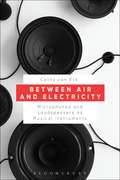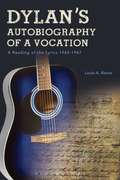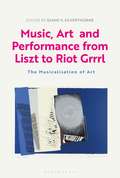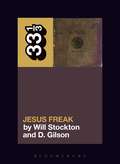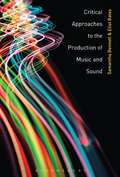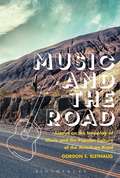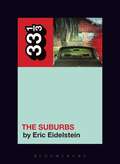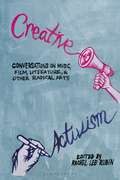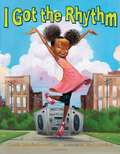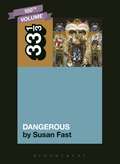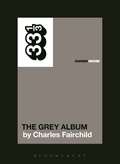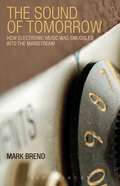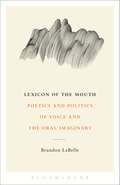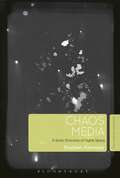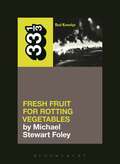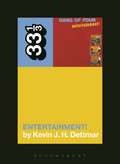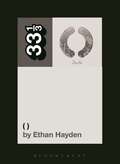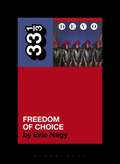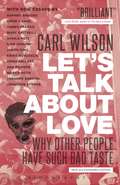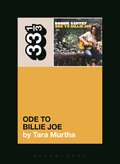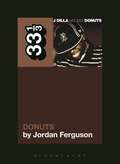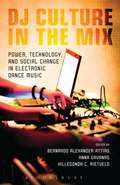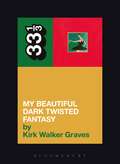- Table View
- List View
Between Air and Electricity: Microphones and Loudspeakers as Musical Instruments
by Cathy Van EckComposers and sound artists have explored for decades how to transform microphones and loudspeakers from “inaudible” technology into genuinely new musical instruments. While the sound reproduction industry had claimed perfect high fidelity already at the beginning of the twentieth century, these artists found surprising ways of use – for instance tweaking microphones, swinging loudspeakers furiously around, ditching microphones in all kinds of vessels, or strapping loudspeakers to body parts of the audience. Between air and electricity traces their quest and sets forward a new theoretical framework, providing historic background on technological and artistic development, and diagrams of concert and performance set-ups. From popular noise musician Merzbow to minimalist classic Alvin Lucier, cult instrument inventor Hugh Davies, or contemporary visual artist Lynn Pook – they all aimed to make audible what was supposed to remain silent.www.microphonesandloudspeakers.com
Dylan's Autobiography of a Vocation: A Reading of the Lyrics 1965-1967
by Louis A. RenzaMany critics have interpreted Bob Dylan's lyrics, especially those composed during the middle to late 1960s, in the contexts of their relation to American folk, blues, and rock 'n' roll precedents; their discographical details and concert performances; their social, political and cultural relevance; and/or their status for discussion as "poems.†? Dylan's Autobiography of a Vocation instead focuses on how all of Dylan's 1965-1967 songs manifest traces of his ongoing, internal "autobiography†? in which he continually declares and questions his relation to a self-determined existential summons.
Music, Art and Performance from Liszt to Riot Grrrl: The Musicalization of Art
by Diane V. SilverthorneOpening with an account of print portraiture facilitating Franz Liszt's celebrity status and concluding with Riot Grrrl's noisy politics of feminism and performance, this interdisciplinary anthology charts the relationship between music and the visual arts from late Romanticism and the birth of modernism to 'postmodernism', while crossing from Western art to the Middle East. Focused on music as a central experience of art and life, these essays scrutinize 'the musicalisation of art' focusing on the visual and performing arts and detailing significant instances of intra-art relations between c. 1840 and the present day. Essays reflect on the aesthetic relationships of music to painting, performance and installation, sound-and- silence, time-and-space. The insistent influence of Wagner is considered as well as the work and ideas of Manet, Satie and Cage, Thomas Wilfred, La Monte Young and Eliasson. What distinguishes these studies are the convictions that music is never alone and that a full understanding of the “isms” of the last two hundred years is best achieved when music's influential presence in the visual arts is acknowledged and interrogated.
dc Talk’s Jesus Freak (33 1/3)
by Will Stockton D. GilsonLate in the Reagan years, three young men at Jerry Falwell's Liberty University formed the Christian rap group dc Talk. The trio put out a series of records that quickly secured their place at the forefront of contemporary Christian music. But, with their fourth studio album Jesus Freak (1995), dc Talk staked a powerful claim on the worldly market of alternative music, becoming an evangelical group with secular selling power.This book sets out to study this mid-90s crossover phenomenon-a moment of cultural convergence between Christian and secular music and an era of particular political importance for American evangelicalism. Written by two queer scholars with evangelical pasts, Jesus Freak explores the importance of a multifarious album with complex ideas about race, sexuality, gender, and politics-an album where dc Talk wonders, “What will people do when they hear that I'm a Jesus freak?” and evangelical fans stake a claim for Christ-like coolness in a secular musical world.
Drive-By Truckers’ Southern Rock Opera (33 1/3)
by Rien FertelThe Drive-By Truckers' Southern Rock Opera takes listeners on a road trip through the American South, with stops along mean old highways and soul-sucking swamps, iconic recording studios and doomed chartered jets, and even Heaven and Hell. Along the way, the Truckers attempt to untangle the mess that is southern history by exploring the contradictory, dualistic nature of the region.Like twin paths intersecting and diverging before meeting again, the opera's libretto focuses on the lives of two bands: the fictional Betamax Guillotine, a stand-in for the Truckers themselves, and Southern rock gods Lynyrd Skynyrd. Rien Fertel takes us for a ride along the Truckers' winding road through the opera's Southlands, a region filled with youthful rockstar aspirations, fatal crashes, the wreckage of one band gone too soon, and the ambitions of another wrestling with the great hope and tragedy that is America.
Critical Approaches to the Production of Music and Sound
by Samantha Bennett Eliot BatesWho produces sound and music? And in what spaces, localities and contexts? As the production of sound and music in the 21st Century converges with multimedia, these questions are critically addressed in this new edited collection by Samantha Bennett and Eliot Bates. Critical Approaches to the Production of Music and Sound features 16 brand new articles by leading thinkers from the fields of music, audio engineering, anthropology and media. Innovative and timely, this collection represents scholars from around the world, revisiting established themes such as record production and the construction of genre with new perspectives, as well as exploring issues in cultural and virtual production.
This Thing Called Life: Prince, Race, Sex, Religion, and Music
by Joseph VogelWhat were Prince's politics? What did he believe about God? And did he really forsake the subject-sex-that once made him the most subversive superstar of the Reagan era? In this illuminating thematic biography, Joseph Vogel explores the issues that made Prince one of the late 20th century's most unique, controversial, and fascinating artists.Since his unexpected death in 2016, Prince has been recognized by peers, critics, and music fans alike. President Barack Obama described him as "one of the most gifted and prolific musicians of our time.†? Yet in spite of the influx of attention, much about Prince's creative life, work, and cultural impact remains thinly examined. This Thing Called Life fills this vacuum, delving deep into seven key topics-politics, sound, race, gender, sex, religion, and death-that allow us to see Prince in fresh, invigorating new ways. Accessible and timely, This Thing Called Life takes the reader on a journey through the catalog and creative revolution of one of America's most compelling and elusive icons.
Music and the Road: Essays on the Interplay of Music and the Popular Culture of the American Road
by Gordon E. SlethaugBrian Wilson and The Beach Boys, Bob Dylan, Bruce Springsteen, and Paul Simon-these familiar figures have written road music for half a century and continue to remain highly-regarded artists. But there is so much more to say about road music. This book fills a glaring hole in scholarship about the road and music. In a collection of 13 essays, Music and the Road explores the origins of road music in the blues, country-western, and rock 'n' roll; the themes of adventure, freedom, mobility, camaraderie, and love, and much more in this music; the mystique and reality of touring as an important part of getting away from home, creating community among performers, and building audiences across the country from the 1930s to the present; and the contribution of music to popular road films such as Bonnie and Clyde, Easy Rider, Thelma and Louise, and On the Road.
Arcade Fire’s The Suburbs (33 1/3)
by Eric EidelsteinThe Suburbs is an incredibly sentimental and nostalgic album, which generally moved critics but was jarring to others. But it also made a heavy impact on fans and – to the surprise of many – won Album of the Year at the 2011 Grammy Awards. This immensely visceral album triggers a sincere celebration of not formative years spent in a cookie-cutter development, but of feeling self-important, immortal, and desperate to escape. It examines youth and amplifies an innate sense of longing and remembrance.Eric Eidelstein's The Suburbs explores this weird, utopic recollection of youth by comparing the album to suburban scenes in film and television, such as Blue Velvet, Mad Men, The Americans, and Spike Jonze's Scenes from the Suburbs. Through the close examination of film and televised depictions of the suburbs, both past and present, Eidelstein delves into the societal factors and artistic depictions that make the suburbs such a fascinating cultural construct, and uncovers why the album creates such a relatable and universal sense of reminiscence.
Creative Activism: Conversations on Music, Film, Literature, and Other Radical Arts
by Rachel Lee RubinThis collection brings together interviews with a compelling range of musicians, artists, and activists from around the globe. What does it mean for an artist to be "political†?? Moving away from a narrow idea about politics that is organized around elections, advocacy groups, or concrete manifestos, the subjects of Creative Activism do their work through song, poetry, painting, and other arts. The interviews take us from Oakland to London to Johannesburg and from the Occupy movement to the coal mines of Appalachia to the fantasy worlds created by some of our most fascinating writers of spectacular fiction. Listening to the important "cultural workers†? of our time challenges any idea that some other time was the golden age of political art: Creative Activism gives us a front-row seat to the thrilling artistic activism of our own moment.
I Got the Rhythm
by Frank Morrison Connie Schofield-MorrisonOn a simple trip to the park, the joy of music overtakes a mother and daughter. The little girl hears a rhythm coming from the world around her- from butterflies, to street performers, to ice cream sellers everything is musical! She sniffs, snaps, and shakes her way into the heart of the beat, finally busting out in an impromptu dance, which all the kids join in on! Award-winning illustrator Frank Morrison and Connie Schofield-Morrison, capture the beat of the street, to create a rollicking read that will get any kid in the mood to boogie.
Michael Jackson's Dangerous (33 1/3)
by Susan FastDangerous is Michael Jackson's coming of age album. Granted, that's a bold claim to make given that many think his best work lay behind him by the time this record was made. It offers Jackson on a threshold, at long last embracing adulthood-politically questioning, sexually charged-yet unable to convince a skeptical public who had, by this time, been wholly indoctrinated by a vicious media. Even though the record sold well, few understood or were willing to accept the depth and breadth of Jackson's vision; and then before it could be fully grasped, it was eclipsed by a shifting pop music landscape and personal scandal-the latter perhaps linked to his assertive new politics. This book tries to cut through the din of dominant narratives about Jackson, taking up the mature, nuanced artistic statement he offered on Dangerous in all its complexity. It is read here as a concept album, one that offers a compelling narrative arc of postmodern angst, love, lust, seduction, betrayal, damnation, and above all else racial politics, in ways heretofore unseen in his music. This record offered a Michael Jackson that was mystifying for a world that had accepted him as a child and as childlike and, hence, as safe; this Michael Jackson was, indeed, dangerous.
Danger Mouse's The Grey Album (33 1/3)
by Charles FairchildThis book marks the tenth anniversary of The Grey Album. The online release and circulation of what Danger Mouse called his 'art project' was an unexpected watershed in the turn-of-the-century brawls over digital creative practice. The album's suppression inspired widespread digital civil disobedience and brought a series of contests and conflicts over creative autonomy in the online world to mainstream awareness. The Grey Album highlighted, by its very form, the profound changes wrought by the new technology and represented the struggle over the tectonic shifts in the production, distribution and consumption of music. But this is not why it matters. The Grey Album matters because it is more than just a clever, if legally ambiguous, amalgam. It is an important and compelling case study about the status of the album as a cultural form in an era when the album appears to be losing its coherence and power. Perhaps most importantly, The Grey Album matters because it changes how we think about the traditions of musical practice of which it is a part. Danger Mouse created a broad, inventive commentary on forms of musical creativity that have defined all kinds of music for centuries: borrowing, appropriation, homage, derivation, allusion and quotation. The struggle over this album wasn't just about who gets to use new technology and how. The battle over The Grey Album struck at the heart of the very legitimacy of a long recognised and valued form of musical expression: the interpretation of the work of one artist by another.
The Sound of Tomorrow: How Electronic Music Was Smuggled into the Mainstream
by Mark BrendLondon, 1966: Paul McCartney met a group of three electronic musicians called Unit Delta Plus. McCartney was there because he had become fascinated by electronic music, and wanted to know how it was made. He was one of the first rock musicians to grasp its potential, but even he was notably late to the party. For years, composers and technicians had been making electronic music for film and TV. Hitchcock had commissioned a theremin soundtrack for Spellbound (1945); The Forbidden Planet (1956) featured an entirely electronic score; Delia Derbyshire had created the Dr Who theme in 1963; and by the early 1960s, all you had to do was watch commercial TV for a few hours to hear the weird and wonderful sounds of the new world. The Sound of Tomorrow tells the compelling story of the sonic adventurers who first introduced electronic music to the masses. A network of composers, producers, technicians and inventors, they took emerging technology and with it made sound and music that was bracingly new.
Lexicon of the Mouth: Poetics and Politics of Voice and the Oral Imaginary
by Brandon LaBelleLexicon of the Mouth surveys the oral cavity as the central channel by which self and surrounding are brought into relation. Questions of embodiment and agency, attachment and loss, incorporation and hunger, locution and the non-sensical are critically examined. In doing so, LaBelle emphasizes the mouth as a vital conduit for negotiating "the foundational narrative of proper speech." Lexicon of the Mouth aims for a viscous, poetic and resonant discourse of subjectivity, detailed through the "micro-oralities" of laughing and whispering, stuttering and reciting, eating and kissing, among others. The oral cavity is posed as an impressionable arena, susceptible to all types of material input, contamination and intervention, while also enabling powerful forms of resistance, attachment and conversation, as well as radical imagination.Lexicon of the Mouth argues for the revolutionary promise of the laugh, the spirited mythologies of the whisper, the schizophonics of self-talk, and the primal noise of gibberish, suggesting that the significance of voicing is fundamentally bound to the exertions of the mouth. Subsequently, assumptions around voice and vocality are unsettled in favor of an epistemology of the oral, highlighting the acts of the tongue, the lips and the throat as primary mediations between interior and exterior, social structures and embodied expressions. LaBelle makes a significant contribution to currents in sound and voice studies by reminding that to hear the voice, and to consider a politics of speech, is first and foremost to assume the mouth.
Chaos Media: A Sonic Economy of Digital Space
by Stephen KennedyThe contemporary media landscape might be described in simple terms as a digital terrain where real and virtual worlds collide. Stephen Kennedy investigates the concept of our digital space leading up to the digital turn of the 1990s to fully understand how our perceptions of orientation in space in time was altered. Chaos Media: A Sonic Economy of Digital Space re-thinks the five fundamental paths to our contemporary understanding of the digital age: cultural, political, economic, scientific, and aesthetic, and ties them together to form a coherent whole in order to demonstrate how critical thinking can be reconfigured using a methodological approach that uses 'chaos' and 'complexity' as systematic tools for studying contemporary mediated space. Kennedy introduces the concept of Sonic Economy, a methodology that allows for a critical engagement with the heterogeneous elements of an information society wherein the dispersion of discrete elements is manifest but not always clearly visible.
Dead Kennedys' Fresh Fruit for Rotting Vegetables (33 1/3)
by Michael Stewart FoleyIn 1978, San Francisco, a city that has seen more than its share of trauma, plunged from a summer of political tension into an autumn cascade of malevolence that so eluded human comprehension it seemed almost demonic. The battles over property taxes and a ballot initiative calling for a ban on homosexuals teaching in public schools gave way to the madness of the Jonestown massacre and the murders of Mayor George Moscone and city supervisor Harvey Milk at the hands of their former colleague, Dan White.In the year that followed this season of insanity, it made sense that a band called Dead Kennedys played Mabuhay Gardens in North Beach, referring to Governor Jerry Brown as a "zen fascist," calling for landlords to be lynched and yuppie gentrifiers to be sent to Cambodia to work for "a bowl of rice a day," critiquing government welfare and defense policies, and, at a time when each week seemed to bring news of a new serial killer or child abduction, commenting on dead and dying children. But it made sense only (or primarily) to those who were there, to those who experienced the heyday of "the Mab."Most histories of the 1970s and 1980s ignore youth politics and subcultures. Drawing on Bay Area zines as well as new interviews with the band and many key figures from the early San Francisco punk scene, Michael Stewart Foley corrects that failing by treating Dead Kennedys' first record, Fresh Fruit for Rotting Vegetables, as a critical historical document, one that not only qualified as political expression but, whether experienced on vinyl or from the stage of "the Mab," stimulated emotions and ideals that were, if you can believe it, utopian.
Gang of Four's Entertainment! (33 1/3)
by Kevin J.H. DettmarFollowing hard on the explosion of British punk, in 1979 Gang of Four produced post-punk's smartest record, Entertainment! For the first time, a band wedded punk's angry energy to funk's propulsive beats-and used that music to put across lyrics that brought a heady mixture of Marxist theory and situationism to exposing the cultural politics of everyday life. But for an American college student from the suburbs-and, one expects, for many, many others, including British youth-Jon King's and Andy Gill's mumbled lyrics were often all but unintelligible. Political rock 'n' roll is always something of an oxymoron: rock audiences by and large don't tune in to be lectured to. But what can it mean that a band that made pop songs as political theory actively resisted making that theory legible? Coming to terms with the impact of Entertainment! requires us to take the mondegreen-the misunderstood lyric-seriously. The old joke has it that the title of R.E.M.'s debut album should have been not Murmur, but Mumble: true, so far as it goes. But that's the title, too, of rock 'n' roll's Greatest Hits compilation-and that strategic inarticulateness itself, which creates such an important role for the listener, has an important politics.
Sigur Rós's (33 1/3)
by Ethan HaydenWords like "inspiring," "expansive," and "moving" are regularly used to describe Sigur Rós's ( ), and yet the only words heard on the record itself are a handful of meaningless nonsense syllables. The album has no title-or rather, its title is no title: just an empty pair of parentheses. The intention being that listeners will fill in the parentheses with their own title, their own interpretation of the sounds on the record. The CD sleeve consists of twelve pages that are essentially blank, lacking song titles, liner notes or production credits. Instead, it contains only semi-translucent frosted images of abstract natural scenes (tree branches, clouds, etc.), on which the listener is free to inscribe their own notes-or no notes at all. And then there are the lyrics, sung in a deliberately unintelligible tongue called "Hopelandic" which the band invites listeners to interpret freely.Ethan Hayden's book doesn't try to fill in the gaps between the album's parentheses, but instead explores the ways in which listeners might attempt to do so. Examining the communicative powers of asemantic language, the book asks whether music can bring sense to nonsense. What happens to the voice when it stops singing conventional language: does it simply become another musical instrument, or is it somehow more "human"? What role does space play on ( )? And how do we interpret music that we cannot possibly understand, but feel very deeply that we do?
Devo's Freedom of Choice (33 1/3)
by Fred Armisen Evie NagyFinally, after all that waiting, The Future arrived in 1980. Ohio art-rockers Devo had plainly prepared with their 1979 second LP Duty Now for the Future, and now it was go time. Propelled by the new decade's high-tech, free-market, pre-AIDS promise, 1980's Freedom of Choice would rocket what Devo co-founder Gerald Casale calls his "alternate universe, hermetically sealed, alien band" both into the arms of the Earthlings and back to their home planet in one scenic trip.Before an artistic and commercial decline that resulted in a 20-year gap between Devo's last two studio records, Freedom of Choice made them curious, insurgent superstars, vindicated but ultimately betrayed by the birth of MTV. Their only platinum album represented the best of their unreplicable code: dead-serious tricksters, embracing conformity in order to destroy it with bullet-proof pop sensibility. Through first-hand accounts from the band and musical analysis set against an examination of new wave's emergence, the first-ever authorized book about Devo (with a foreword by Portlandia's Fred Armisen) explores the group's peak of success, when their hermetic seal cracked open to let in mainstream attention, a legion of new Devotees, and plenty of misunderstandings. "Freedom of Choice was the end of Devo innocence–it turned out to be the high point before the s***storm of a total cultural move to the right, the advent of AIDS, and the press starting to figure Devo out and think they had our number," says Casale. "It's where everything changes."
Let's Talk About Love: Why Other People Have Such Bad Taste
by Carl WilsonFor his 2007 critically acclaimed 33 1/3 series title, Let's Talk About Love, Carl Wilson went on a quest to find his inner Céline Dion fan and explore how we define ourselves by what we call good and bad, what we love and what we hate. At once among the most widely beloved and most reviled and lampooned pop stars of the past few decades, Céline Dion's critics call her mawkish and overblown while millions of fans around the world adore her "huge pipes†? and even bigger feelings. How can anyone say which side is right? This new, expanded edition goes even further, calling on thirteen prominent writers and musicians to respond to themes ranging from sentiment and kitsch to cultural capital and musical snobbery. The original text is followed by lively arguments and stories from Nick Hornby, Krist Novoselic, Ann Powers, Mary Gaitskill, James Franco, Sheila Heti and others. In a new afterword, Carl Wilson examines recent cultural changes in love and hate, including the impact of technology and social media on how taste works (or doesn't) in the 21st century.
Bobbie Gentry's Ode to Billie Joe (33 1/3)
by Tara MurthaJuly, 1967: It seems the entire country stopped to listen to a husky voice steeped in the simmering secrets of the South tell a tragic tale of teenage suicide. So much for the Summer of Love. "Ode to Billie Joe†? knocked the Beatles' "All You Need is Love†? off the top of the charts, and Bobbie Gentry became an international star. Almost 50 years later, Gentry is as enigmatic and captivating as her signature song. Of course, fans still want to know why Billie Joe McAllister jumped off the Tallahatchie Bridge. They also wonder: Why did Bobbie Gentry, who has not performed or made a public appearance since the early 1980s, leave it all behind? Through extensive interviews and unprecedented access to career memorabilia, Murtha explores the real-life mysteries ensnarled within the much-disputed origin of Ode to Billie Joe. The result is an investigative pop history that reveals, for the first time, the full breadth of Bobbie Gentry's groundbreaking career-and just may help explain her long silence. Foreword by musician Jill Sobule.
J Dilla's Donuts (33 1/3)
by Jordan FergusonFrom a Los Angeles hospital bed, equipped with little more than a laptop and a stack of records, James "J Dilla†? Yancey crafted a set of tracks that would forever change the way beatmakers viewed their artform. The songs on Donuts are not hip hop music as "hip hop music†? is typically defined; they careen and crash into each other, in one moment noisy and abrasive, gorgeous and heartbreaking the next. The samples and melodies tell the story of a man coming to terms with his declining health, a final love letter to the family and friends he was leaving behind. As a prolific producer with a voracious appetite for the history and mechanics of the music he loved, J Dilla knew the records that went into constructing Donuts inside and out. He could have taken them all and made a much different, more accessible album. If the widely accepted view is that his final work is a record about dying, the question becomes why did he make this record about dying?Drawing from philosophy, critical theory and musicology, as well as Dilla's own musical catalogue, Jordan Ferguson shows that the contradictory, irascible and confrontational music found on Donuts is as much a result of an artist's declining health as it is an example of what scholars call "late style,†? placing the album in a musical tradition that stretches back centuries.
DJ Culture in the Mix: Power, Technology, and Social Change in Electronic Dance Music
by Anna Gavanas Bernardo Attias Hillegonda RietveldThe DJ stands at a juncture of technology, performance and culture in the increasingly uncertain climate of the popular music industry, functioning both as pioneer of musical taste and gatekeeper of the music industry. Together with promoters, producers, video jockeys (VJs) and other professionals in dance music scenes, DJs have pushed forward music techniques and technological developments in last few decades, from mashups and remixes to digital systems for emulating vinyl performance modes. This book is the outcome of international collaboration among academics in the study of electronic dance music. Mixing established and upcoming researchers from the US, Canada, the UK, Germany, Austria, Sweden, Australia and Brazil, the collection offers critical insights into DJ activities in a range of global dance music contexts. In particular, chapters address digitization and performativity, as well as issues surrounding the gender dynamics and political economies of DJ cultures and practices.
Kanye West's My Beautiful Dark Twisted Fantasy (33 1/3)
by Kirk Walker GravesIn the first decade of the twenty-first century, Kanye West created the most compelling body of pop music by an American artist during the period. Having risen from obscurity as a precocious producer through the ranks of Jay Z's Roc-A-Fella records, by the time he released My Beautiful Dark Twisted Fantasy (MBDTF) in late 2010, West had evolved into a master collagist, an alchemist capable of transfiguring semi-obscure soul samples and indelible beats into a brash and vulnerable new art form. A look at the arc of his career, from the heady chipmunk soul exuberance of The College Dropout (2004) to the operatic narcissism of MBDTF, tells us about the march of pop music into the digital age and, by extension, the contradictions that define our cultural epoch. In a cloud-based and on-demand culture – a place of increasing virtualization, loneliness, and hyper-connectivity – West straddles this critical moment as what David Samuels of The Atlantic calls "the first true genius of the iPhone era, the Mozart of contemporary American music." In the land of taking a selfie, honing a personal brand, and publicly melting down online, Kanye West is the undisputed king. Swallowing the chaos wrought by his public persona and digesting it as a grandiose allegory of self-redemption, Kanye sublimates his narcissism to paint masterstroke after masterstroke on MBDTF, a 69-minute hymn to egotistical excess. Sampling and ventriloquizing the pop music past to tell the story of its future – very much a tale of our culture's wish for unfettered digital ubiquity – MBDTF is the album of its era, an aesthetic self-acquittal and spiritual autobiography of our era's most dynamic artist.
